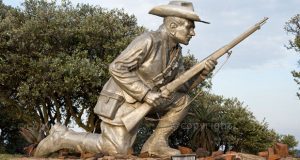16 DECEMBER 1848, Title deeds to the farm Bultfontein granted to JF Otto.
16 DECEMBER 1899, Mayor of Beaconsfield, Fred Blacking, dies in harness.
DID YOU KNOW
There were many diggers who moved away from the crowded alluvial diggings along the Vaal river during 1869 and 1870 – the river being roughly 30 kilometres from Kimberley – and many stories in print state there were traces of earlier excavations and tunnels before diamonds were eventually discovered in the veld and kopjes of the farms Dorstfontein, Bultfontein, Vooruitzicht and Benaauwheidsfontein. All the newspapers – the Cape Argus, the Grahamstown Journal, the Standard and Diggers Mail, the Friend of the Free State and Bloemfontein Gazette, are filled with stories of discoveries of diamonds well away from the rivers, notably in the Fauresmith, Boshof and Bloemhof regions. One such report mentioned that a man named Hartlegen from Fauresmith brought a diamond to Colesberg for verification in either June or July 1869.
In November 1869 it was announced that a diamond mine had been discovered some three hours ride from Jacobsdal in the Free State, this probably being the Jagersfontein Mine. An overseer of the Jagersfontein farm named De Klerk had found a 50-carat diamond while he had been prospecting in a riverbed, and within weeks prospectors were paying £2 a month for digging permits. Jagersfontein was being mined extensively by October 1870, with the Koffiefontein Mine being discovered that same month according to the Grahamstown Journal, although there are contradicting reports on the discovery of this mine.
Louis Hond, a lapidary from Holland, later to be intimately involved in the Bultfontein Mine, was based in Hopetown and was probably the most knowledgeable diamond expert available at the time. Employed by him were Leopold Lilienfeld (of Lilienfeld Brothers), and Stafford Parker, both becoming well-known characters of the diamond fields, particularly the latter when he became President of the Diggers Republic at Klipdrift. Klipdrift was re-named Parkertown in his honour, but the Republic was short-lived and the town’s name reverted to Klipdrift and later became Barkly West. In a letter to the Grahamstown Journal dated 28 July 1869, Hond was quite prophetic about diamonds in other places other than the rivers in that “…in some localities as well as the Vaal River diamonds are to be discovered.” It was to Hond that all finders of diamonds were coming to in Hopetown, and the indigenous Griqua towns were all but deserted as the “…Griquas were searching in all areas…” for up to six hours a day. The Griquas would have told him the general area where they had found the diamond so perhaps his prophecy was a logical conclusion.
The Lilienfeld Brothers, Martin, Gustav and Leopold, had the largest trading store in Hopetown, and by the time the ‘Star of South Africa’ diamond was brought in on 19 March 1869, were already well established in the diamond buying business, and had financial agreements with A Mosenthal of Port Elizabeth. Mosenthal was later a De Beers Company Director. Louis Hond was their adviser, and he too had a store in Hopetown called L. Hond and Company.
More of a prophet was a gentleman named Mr Mons, a regular correspondent to the Cape Argus, who stated in 1867, and again in September 1869, that there must be a diamond mine somewhere in the region. How right he was.
The farms that make up what is now the general Kimberley region were Dorstfontein, Bultfontein, Vooruitzicht, Alexandersfontein and Benaauwheidsfontein and are situated in latitude 28 degrees 42 minutes 54 seconds south, and longitude 24 degrees 46 minutes east. The title deeds to the farm Bultfontein were granted by the British Government then controlling the Orange River Sovereignty, under Warden Certificate to J.F. Otto on 16 December 1848. This was the first farm to be settled by white Boers. Dorstfontein was granted by the Orange Free State Government to Abraham Paulus du Toit on 4 April 1860, while Vooruitzicht, formerly a portion of Bultfontein was sold to the brothers Diedrich Arnoldus and Johannes Nicolaas de Beer two weeks after he had received his title deeds, on 18 April 1860. Whether Otto sold the land is not known, but there are documents that suggest the Free State Government sold it to the De Beers brothers for £50. There are some discrepancies here as Alpheus Williams records that Vooruitzicht was sold on 27 December 1863 to the De Beers brothers.
Shortlink for this post: https://www.kimberley.org.za/?p=25457







